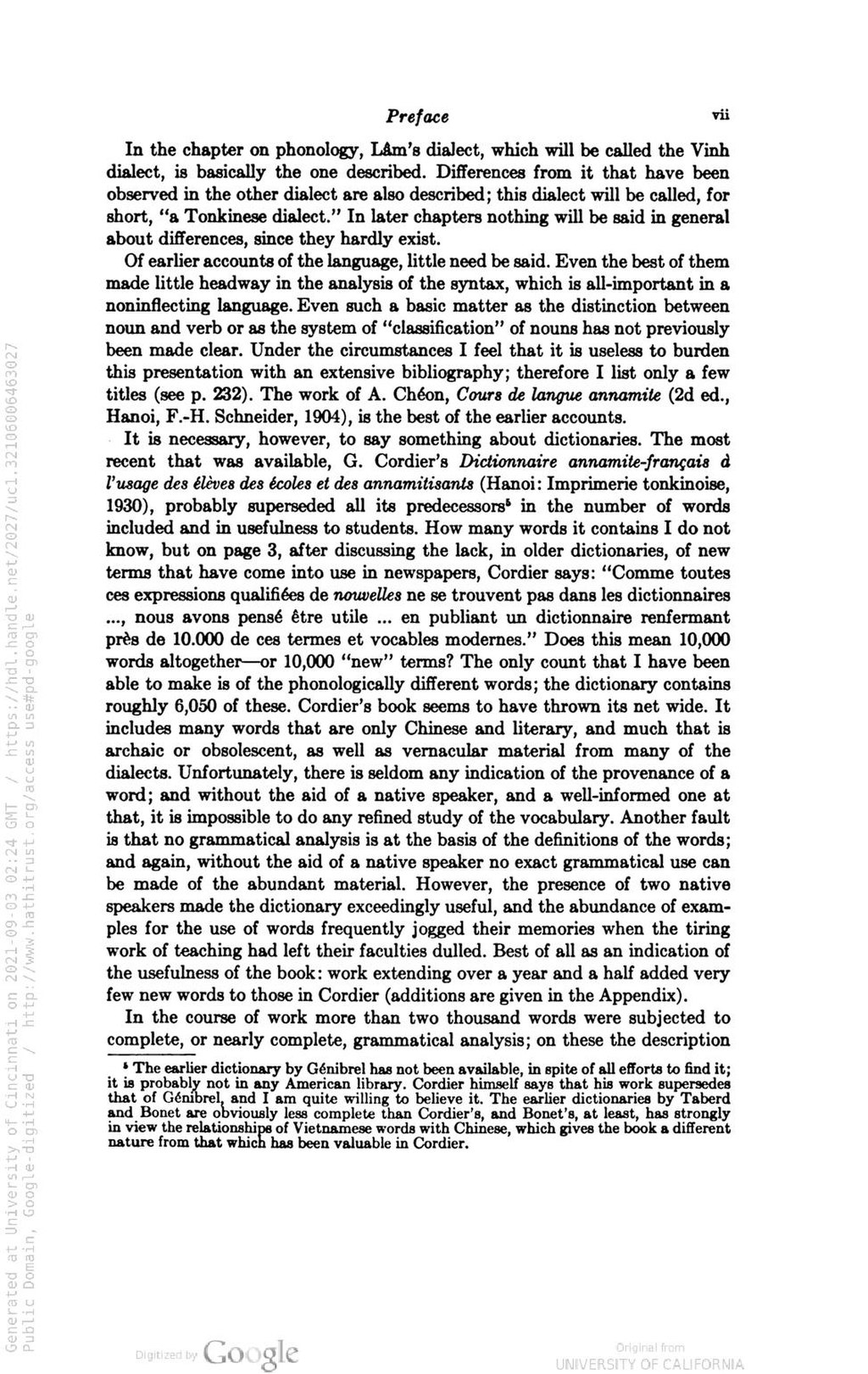In the chapter on phonology, Lâm's dialect, which will be called the Vinh dialect, is basically the one described. Differences from it that have been observed in the other dialect are also described; this dialect will be called, for short, "a Tonkinese dialect." In later chapters nothing will be said in general about differences, since they hardly exist.
Of earlier accounts of the language, little need be said. Even the best of them made little headway in the analysis of the syntax, which is all-important in a noninflecting language. Even such a basic matter as the distinction between noun and verb or as the system of "classification" of nouns has not previously been made clear. Under the circumstances I feel that it is useless to burden this presentation with an extensive bibliography; therefore I list only a few titles (see p. 232). The work of A. Chéon, Cours de langue annamite (2d ed., Hanoi, F.-H. Schneider, 1904), is the best of the earlier accounts.
It is necessary, however, to say something about dictionaries. The most recent that was available, G. Cordier's Dictionnaire annamite-français à l'usage des élèves des écoles et des annamitisants (Hanoi: Imprimerie tonkinoise, 1930), probably superseded all its predecessors[1] in the number of words included and in usefulness to students. How many words it contains I do not know, but on page 3, after discussing the lack, in older dictionaries, of new terms that have come into use in newspapers, Cordier says: "Comme toutes ces expressions qualifiées de nouvelles ne se trouvent pas dans les dictionnaires ..., nous avons pensé être utile ... en publiant un dictionnaire renfermant près de 10.000 de ces termes et vocables modernes." Does this mean 10,000 words altogether-or 10,000 "new" terms? The only count that I have been able to make is of the phonologically different words; the dictionary contains roughly 6,050 of these. Cordier's book seems to have thrown its net wide. It includes many words that are only Chinese and literary, and much that is archaic or obsolescent, as well as vernacular material from many of the dialects. Unfortunately, there is seldom any indication of the provenance of a word; and without the aid of a native speaker, and a well-informed one at that, it is impossible to do any refined study of the vocabulary. Another fault is that no grammatical analysis is at the basis of the definitions of the words; and again, without the aid of a native speaker no exact grammatical use can be made of the abundant material. However, the presence of two native speakers made the dictionary exceedingly useful, and the abundance of examples for the use of words frequently jogged their memories when the tiring work of teaching had left their faculties dulled. Best of all as an indication of the usefulness of the book: work extending over a year and a half added very few new words to those in Cordier (additions are given in the Appendix).
In the course of work more than two thousand words were subjected to complete, or nearly complete, grammatical analysis; on these the description
- ↑ The earlier dictionary by Génibrel has not been available, in spite of all efforts to find it; it is probably not in any American library. Cordier himself says that his work supersedes that of Génibrel, and I am quite willing to believe it. The earlier dictionaries by Taberd and Bonet are obviously less complete than Cordier's, and Bonet's, at least, has strongly in view the relationships of Vietnamese words with Chinese, which gives the book a different nature from that which has been valuable in Cordier.
